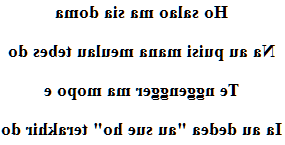Rote love poem
Ho salao ma sia doma
Na au puisi mana meulau tebes do
Te nggengger ma mopo e
Ia au dedea "au sue ho" terakhir do
The words "puisi" and "terakhir", respectively "poem" and "last" are here in Indonesian, the translator does not know them in roti.


→ French poem ←
Rote language
The translation of my love poem into the Rote language (Roti, Rotte, Rotti, Lote), from Rote Island, which is one of the small Sunda Islands in Indonesia. I dedicate it to all the women of the Rote ethnic groups!
Rote, is a language of the central-eastern group of Austronesian languages.
The inhabitants of Rote Island, call themselves Lotes; it is with the influence of Dutch that the names of these natives, and their language, have often been written: Rotte, Rotti, Roti.
On Rote, the Malay language has been used since the 17th century, at this time, to correspond with the governance of Batavia. And it is ultimately, the Malay, widely associated with Christianity, which will be used as a literary language.
The stories of Aba Nabas (adviser of the Sultan Harun ar rasyid), are very popular. The inhabitants of Rotte, consider him as the hero who reflects them; these edited and re-edited stories are part of their literature.
Likewise, an oral poem, sung in a ritual manner, the Bini, reveals that the succession of things, even when it is question of power, is of a natural order, and must be respected ... moreover, this word respect, is essential for them.
Rote people and Roti Island
Roti (Rote) is an island located off the southwestern tip of the island of Timor, in the province of East Nusa Tenggara with a population of 95,000.
It is an arid island, sterile and poor of natural resources. Its inhabitants, live from a little breeding, fishing and agriculture (rice, corn, cotton), and especially from the exploitation of palm trees, for palm sugar.
The ancestors of the Rote people would have arrived from Sera Sue do Dai Laka or Seram in Maluku, via Flores and Timor (Mubyarto, 1991).
The social model of these populations is the nusak, based on a kinship group called Leo, under the leadership of a Manek (chief) called Manelo ... all grouped together in territorial communities.
Within each nusak (there are 18), there is a unique language and culture, which could make communication between villages difficult; but for the people of Roti Island, diversity, cultural and linguistic, rather than being a problem is seen as normal, and a richness ... and emphasizing its differences, allows them to show their identity, and the pride they have in respecting each other.